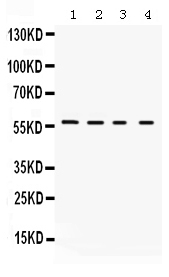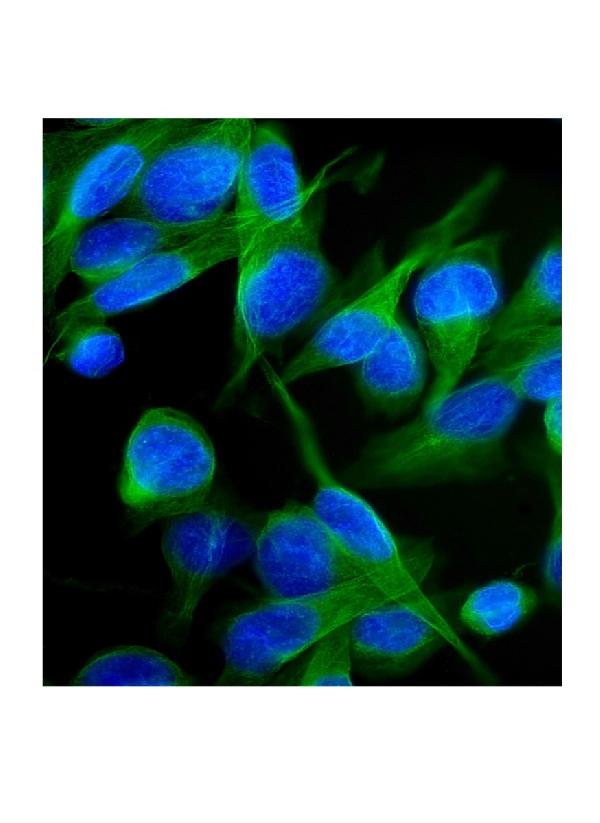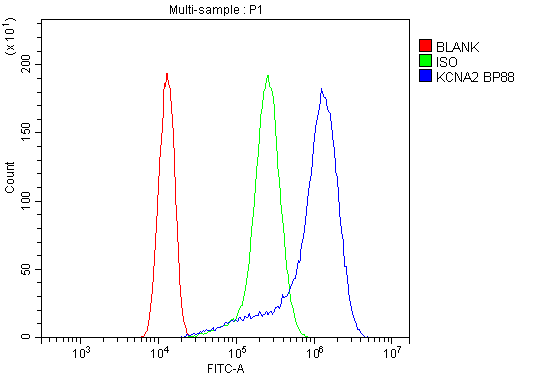Product Info Summary
| SKU: | PB9649 |
|---|---|
| Size: | 100 μg/vial |
| Reactive Species: | Human, Mouse, Rat |
| Host: | Rabbit |
| Application: | Flow Cytometry, IF, ICC, WB |
Customers Who Bought This Also Bought
Product info
Product Name
Anti-Kv1.2/KCNA2 Antibody Picoband®
SKU/Catalog Number
PB9649
Size
100 μg/vial
Form
Lyophilized
Description
Boster Bio Anti-Kv1.2/KCNA2 Antibody Picoband® catalog # PB9649. Tested in Flow Cytometry, IF, ICC, WB applications. This antibody reacts with Human, Mouse, Rat. The brand Picoband indicates this is a premium antibody that guarantees superior quality, high affinity, and strong signals with minimal background in Western blot applications. Only our best-performing antibodies are designated as Picoband, ensuring unmatched performance.
Storage & Handling
Store at -20˚C for one year from date of receipt. After reconstitution, at 4˚C for one month. It can also be aliquotted and stored frozen at -20˚C for six months. Avoid repeated freeze-thaw cycles.
Cite This Product
Anti-Kv1.2/KCNA2 Antibody Picoband® (Boster Biological Technology, Pleasanton CA, USA, Catalog # PB9649)
Host
Rabbit
Contents
Each vial contains 5mg BSA, 0.9mg NaCl, 0.2mg Na2HPO4, 0.05mg NaN3.
Clonality
Polyclonal
Isotype
Rabbit IgG
Immunogen
A synthetic peptide corresponding to a sequence at the C-terminus of human Kv1.2, identical to the related mouse and rat sequences.
*Blocking peptide can be purchased. Costs vary based on immunogen length. Contact us for pricing.
Cross-reactivity
No cross-reactivity with other proteins
Reactive Species
PB9649 is reactive to KCNA2 in Human, Mouse, Rat
Reconstitution
Add 0.2ml of distilled water will yield a concentration of 500ug/ml.
Observed Molecular Weight
57 kDa
Calculated molecular weight
56717 MW
Background of KCNA2
Potassium voltage-gated channel subfamily A member 2, also known as Kv1.2, is a protein that in humans is encoded by the KCNA2 gene. Potassium channels represent the most complex class of voltage-gated ion channels from both functional and structural standpoints. Their diverse functions include regulating neurotransmitter release, heart rate, insulin secretion, neuronal excitability, epithelial electrolyte transport, smooth muscle contraction, and cell volume. Four sequence-related potassium channel genes - shaker, shaw, shab, and shal - have been identified in Drosophila, and each has been shown to have human homolog (s). This gene encodes a member of the potassium channel, voltage-gated, shaker-related subfamily. This member contains six membrane-spanning domains with a shaker-type repeat in the fourth segment. It belongs to the delayed rectifier class, members of which allow nerve cells to efficiently repolarize following an action potential. The coding region of this gene is intronless, and the gene is clustered with genes KCNA3 and KCNA10 on chromosome 1.
Antibody Validation
Boster validates all antibodies on WB, IHC, ICC, Immunofluorescence, and ELISA with known positive control and negative samples to ensure specificity and high affinity, including thorough antibody incubations.
Application & Images
Applications
PB9649 is guaranteed for Flow Cytometry, IF, ICC, WB Boster Guarantee
Assay Dilutions Recommendation
The recommendations below provide a starting point for assay optimization. The actual working concentration varies and should be decided by the user.
Western blot, 0.1-0.5μg/ml, Mouse, Rat
Immunocytochemistry/Immunofluorescence, 2μg/ml, Human
Flow Cytometry (Fixed), 1-3μg/1x106 cells, Human, Rat
Positive Control
WB: Rat Kidney Tissue, Rat Brain Tissue, Mouse Brain Tissue, Mouse Kidney Tissue
ICC/IF: U20S cell
FCM: A431 cell, C6 cell
Validation Images & Assay Conditions

Click image to see more details
Figure 1. Western blot analysis of Kv1.2 using anti-Kv1.2 antibody (PB9649).
Electrophoresis was performed on a 5-20% SDS-PAGE gel at 70V (Stacking gel) / 90V (Resolving gel) for 2-3 hours.
Lane 1: Rat Kidney Tissue Lysate at 50ug,
Lane 2: Rat Brain Tissue Lysate at 50ug,
Lane 3: Mouse Brain Tissue Lysate at 50ug,
Lane 4: Mouse Kidney Tissue Lysate at 50ug.
After electrophoresis, proteins were transferred to a nitrocellulose membrane at 150 mA for 50-90 minutes. Blocked the membrane with 5% non-fat milk/TBS for 1.5 hour at RT. The membrane was incubated with rabbit anti-Kv1.2 antigen affinity purified polyclonal antibody (Catalog # PB9649) at 0.5 μg/mL overnight at 4°C, then washed with TBS-0.1%Tween 3 times with 5 minutes each and probed with a goat anti-rabbit IgG-HRP secondary antibody at a dilution of 1:5000 for 1.5 hour at RT. The signal is developed using an Enhanced Chemiluminescent detection (ECL) kit (Catalog # EK1002) with Tanon 5200 system. A specific band was detected for Kv1.2 at approximately 57 kDa. The expected band size for Kv1.2 is at 57 kDa.

Click image to see more details
Figure 2. IF analysis of Kv1.2 using anti-Kv1.2 antibody (PB9649).
Kv1.2 was detected in immunocytochemical section of U20S cells. Enzyme antigen retrieval was performed using IHC enzyme antigen retrieval reagent (AR0022) for 15 mins. The cells were blocked with 10% goat serum. And then incubated with 2μg/mL rabbit anti-Kv1.2 Antibody (PB9649) overnight at 4°C. DyLight®488 Conjugated Goat Anti-Rabbit IgG (BA1127) was used as secondary antibody at 1:100 dilution and incubated for 30 minutes at 37°C. The section was counterstained with DAPI. Visualize using a fluorescence microscope and filter sets appropriate for the label used.

Click image to see more details
Figure 3. Flow Cytometry analysis of A431 cells using anti-Kv1.2 antibody (PB9649).
Overlay histogram showing A431 cells stained with PB9649 (Blue line). To facilitate intracellular staining, cells were fixed with 4% paraformaldehyde and permeabilized with permeabilization buffer. The cells were blocked with 10% normal goat serum. And then incubated with rabbit anti-Kv1.2 Antibody (PB9649,1μg/1x106 cells) for 30 min at 20°C. DyLight®488 conjugated goat anti-rabbit IgG (BA1127, 5-10μg/1x106 cells) was used as secondary antibody for 30 minutes at 20°C. Isotype control antibody (Green line) was rabbit IgG (1μg/1x106) used under the same conditions. Unlabelled sample without incubation with primary antibody and secondary antibody (Red line) was used as a blank control.

Click image to see more details
Figure 4. Flow Cytometry analysis of C6 cells using anti-Kv1.2 antibody (PB9649).
Overlay histogram showing C6 cells stained with PB9649 (Blue line). The cells were fixed with 4% paraformaldehyde and blocked with 10% normal goat serum. And then incubated with rabbit anti-Kv1.2 Antibody (PB9649,1μg/1x106 cells) for 30 min at 20°C. DyLight®488 conjugated goat anti-rabbit IgG (BA1127, 5-10μg/1x106 cells) was used as secondary antibody for 30 minutes at 20°C. Isotype control antibody (Green line) was rabbit IgG (1μg/1x106) used under the same conditions. Unlabelled sample without incubation with primary antibody and secondary antibody (Red line) was used as a blank control.
Protein Target Info & Infographic
Gene/Protein Information For KCNA2 (Source: Uniprot.org, NCBI)
Gene Name
KCNA2
Full Name
Potassium voltage-gated channel subfamily A member 2
Weight
56717 MW
Superfamily
potassium channel family
Alternative Names
Potassium voltage-gated channel subfamily A member 2;NGK1;Voltage-gated K (+) channel HuKIV ;Voltage-gated potassium channel HBK5;Voltage-gated potassium channel subunit Kv1.2;KCNA2; KCNA2 DEE32, EIEE32, HBK5, HK4, HUKIV, KV1.2, MK2, NGK1, RBK2 potassium voltage-gated channel subfamily A member 2 potassium voltage-gated channel subfamily A member 2|potassium channel, voltage gated shaker related subfamily A, member 2|potassium voltage-gated channel, shaker-related subfamily, member 2|voltage-gated K(+) channel HuKIV|voltage-gated potassium channel HBK5|voltage-gated potassium channel protein Kv1.2|voltage-gated potassium channel subunit Kv1.2
*If product is indicated to react with multiple species, protein info is based on the gene entry specified above in "Species".For more info on KCNA2, check out the KCNA2 Infographic

We have 30,000+ of these available, one for each gene! Check them out.
In this infographic, you will see the following information for KCNA2: database IDs, superfamily, protein function, synonyms, molecular weight, chromosomal locations, tissues of expression, subcellular locations, post-translational modifications, and related diseases, research areas & pathways. If you want to see more information included, or would like to contribute to it and be acknowledged, please contact [email protected].
Specific Publications For Anti-Kv1.2/KCNA2 Antibody Picoband® (PB9649)
Hello CJ!
No publications found for PB9649
*Do you have publications using this product? Share with us and receive a reward. Ask us for more details.
Recommended Resources
Here are featured tools and databases that you might find useful.
- Boster's Pathways Library
- Protein Databases
- Bioscience Research Protocol Resources
- Data Processing & Analysis Software
- Photo Editing Software
- Scientific Literature Resources
- Research Paper Management Tools
- Molecular Biology Software
- Primer Design Tools
- Bioinformatics Tools
- Phylogenetic Tree Analysis
Customer Reviews
Have you used Anti-Kv1.2/KCNA2 Antibody Picoband®?
Submit a review and receive an Amazon gift card.
- $30 for a review with an image
0 Reviews For Anti-Kv1.2/KCNA2 Antibody Picoband®
Customer Q&As
Have a question?
Find answers in Q&As, reviews.
Can't find your answer?
Submit your question
4 Customer Q&As for Anti-Kv1.2/KCNA2 Antibody Picoband®
Question
My question regarding product PB9649, anti-Kv1.2/KCNA2 antibody. I was wondering if it would be possible to conjugate this antibody with biotin. I would need it to be without BSA or sodium azide. I am planning on using a buffer exchange of sodium azide with PBS only. Would there be problems for me to conjugate the antibody and store it in -20 degrees in small aliquots?
Verified Customer
Verified customer
Asked: 2020-04-14
Answer
We do not recommend storing this antibody with PBS buffer only in -20 degrees. If you want to store it in -20 degrees it is best to add some cryoprotectant like glycerol. If you want carrier free PB9649 anti-Kv1.2/KCNA2 antibody, we can provide it to you in a special formula with trehalose and/or glycerol. These molecules will not interfere with conjugation chemistry and provide a good level of protection for the antibody from degradation. Please be sure to specify this in your purchase order.
Boster Scientific Support
Answered: 2020-04-14
Question
Is there a BSA free version of anti-Kv1.2/KCNA2 antibody PB9649 available?
Verified Customer
Verified customer
Asked: 2020-04-02
Answer
We appreciate your recent telephone inquiry. I can confirm that some lots of this anti-Kv1.2/KCNA2 antibody PB9649 are BSA free. For now, these lots are available and we can make a BSA free formula for you free of charge. It will take 3 extra days to prepare. If you require this antibody BSA free again in future, please do not hesitate to contact me and I will be pleased to check which lots we have in stock that are BSA free.
Boster Scientific Support
Answered: 2020-04-02
Question
Is a blocking peptide available for product anti-Kv1.2/KCNA2 antibody (PB9649)?
Verified Customer
Verified customer
Asked: 2020-03-23
Answer
We do provide the blocking peptide for product anti-Kv1.2/KCNA2 antibody (PB9649). If you would like to place an order for it please contact [email protected] and make a special request.
Boster Scientific Support
Answered: 2020-03-23
Question
We are currently using anti-Kv1.2/KCNA2 antibody PB9649 for human tissue, and we are well pleased with the WB results. The species of reactivity given in the datasheet says human, mouse, rat. Is it likely that the antibody can work on canine tissues as well?
Verified Customer
Verified customer
Asked: 2019-06-21
Answer
The anti-Kv1.2/KCNA2 antibody (PB9649) has not been validated for cross reactivity specifically with canine tissues, but there is a good chance of cross reactivity. We have an innovator award program that if you test this antibody and show it works in canine you can get your next antibody for free. Please contact me if I can help you with anything.
Boster Scientific Support
Answered: 2019-06-21





